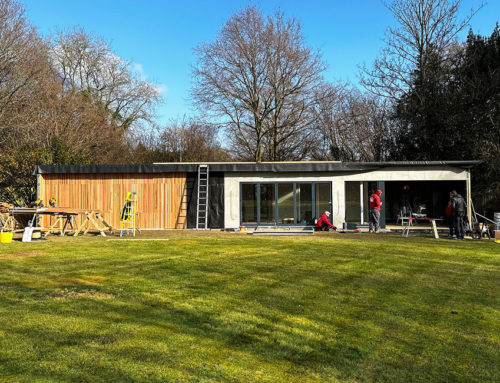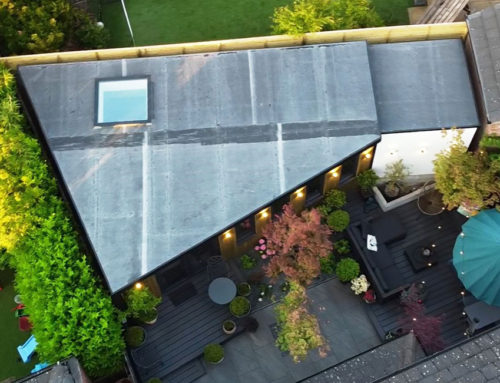
From time to time we are asked how to avoid condensation in a garden room. Water vapour is invisible until we see it condense, often on window surfaces around the home. What is condensation, where does it come from and how can you stop it from forming? Let’s find out.
What is condensation?
We’ve all seen condensation form on the inside of our windows and on the bathroom mirror when showering. How is it caused and what can we do to reduce or even eliminate it? The condensation we see on household and garden room surfaces are the tiny droplets of water. This can emerge when warm air meets a cold surface, such as a window, and especially during winter weather.
Why does it appear?
Condensation is a common phenomenon in winter. It can happen when your heating system activates in the cooler hours of the morning and evening. Warmer air is capable of holding larger amounts of water. Normal everyday activities, like bathing or boiling a kettle, release moisture into the air in your home. When this moist air cools quickly against a cold surface, it can no longer hold onto it’s water content. That is when moisture is left behind as visible liquid droplets.
As we all know, this is rarely seen in the summer. The quantity of water in the air (known as humidity), both inside our homes and garden rooms, is much higher during the winter months. Because we turn the heating up and keep windows closed we trap that moist air in. When the outside temperature falls, liquid water begins to appear inside your home. We see this mostly on windows, as glass is a good conductor the panels cool down inline with the low outdoor temperature. Also, the smaller the space, the greater the chance you will see condensation on the window panes.
So what are the implications of humidity in a garden room? Well, condensation can creep behind wallpaper, bathroom and kitchen tiles and even paint, causing surfaces to blister, distort and crack. Moisture can also seriously damage timber framework and wooden objects. If the situation is not dealt with you may even begin to find mould forming in damp areas.

Where is the water vapour coming from?
Water vapour enters your home, garden office or annex through a variety of sources, but the most obvious are:
Bathing – When we shower or have a bath, hot water produces steam. Most bathrooms have extractor fans to remove as much moist air as possible but are often not as effective as we would like.
Drying clothes – When we dry clothing indoors the water in the wet garments simply evaporates and travels around our homes.
Cooking – Most cooking, or even just boiling the kettle, releases steam which then stays present inside your house.
Breathing – Humans and animals breath out warm humid air throughout the day and night.
Once water vapour is inside your home you won’t notice its presence until it forms condensation. If the temperature of windows and sills sit above the dew point then the vapour will not condense and you don’t even realise it is there.
How do you stop condensation from forming?
It’s tempting to believe that there is must be a flaw in your building if you find condensation, but in most cases it’s is a sign of a well sealed structure which is just being used for everyday activities. In our recent past, homes were draughty and cold as they were badly sealed and poorly insulated; not ideal for comfort but excellent at reducing warm air and associated humidity. Draughts allow fresh air (containing less moisture) in to replace the current moisture laden air. If a garden room is very poorly insulated you will see condensation on the walls and even ceiling as well as the windows as these surfaces will all be cold. Also, the smaller and better sealed a structure is the more likely you are to see condensation.
Most garden buildings and modern homes are nearly air-tight which increases the likelihood of condensation, this is completely normal if you are actively using the space. As we are well aware of this we make sure that our buildings contain ventilation, often with a powered fan. This is not an answer on it’s own though, as enough ventilation to entirely avoid condensation would mean the buildings would never be heated adequately and would also always be draughty. Simply having a window or two open, and allowing fresh air to circulate for a couple of hours a day, can completely stop condensation from forming.
Part of how we keep our garden rooms insulated is also by using products ideal for high-level ventilation. The MRXBOX-ECO Heat Recovery Units are one of the professional systems we use to avoid condensation and keep your home warm during cold winters.

Some helpful tips to help you avoid condensation
If you do discover condensation, use a “squeegee” and a paper towel to clear any water droplets from your windows. Leaving it to evaporate back into the air, so it can condense again, makes little sense.
When you use the kitchen or bathroom try to close the doors to your other rooms to avoid condensation forming.
Your bathroom extractor fan should be running whenever you have shower or a bath and if the room is still steamy when you have finished then leave the extractor running or open a window.
Most importantly, air out your garden room every day it is in use and especially well during the colder months. There is no substitute for allowing stale air out and the fresh air in. This is why we specify open tilt windows on our garden buildings. They are an excellent solution to allow air exchange with the outdoors whilst still being able to control the temperature of your garden room.
If, because of the way you are using your garden room, you cannot seem to stop condensation from forming, a small quiet dehumidifier is probably the answer. If a room, or an area of a room, seems to attract condensation no matter what then these devices helpfully condense the water vapour from the air, holding it in an internal reservoir until emptied. They can be especially helpful in the coldest parts of the year when we see the largest temperature differential between indoors and outside, this is also the time when we are most likely to bring wet clothes and objects indoors.
Ultimately, condensation is a problem created by us simply using our garden rooms as intended. It can be solved by limiting the creation of water vapour, but when vapour is present we should use ventilation to allow the moist air to leave and the fresh dry air to enter.



